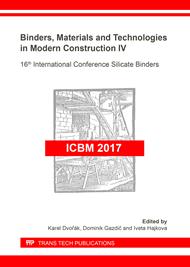p.35
p.41
p.47
p.53
p.60
p.69
p.75
p.83
p.89
Study of the Hydration Process of Synthetic Preparation of Ettringite by Direct Addition of Aluminum Sulfate and Calcium Hydroxide
Abstract:
The stability of ettringite as high-watery mineral is highly dependent on the ambient temperature. Under standard laboratory conditions, onset of decomposition of this phase occurs at temperature of 80°C already and the theoretical temperature of the complete decomposition of ettringite is 180°C. Ettringite decomposition can occur at significantly different temperatures under humidity conditions other than the laboratory ones. Within the work verification of the possibility of synthetic preparation of ettringite by direct addition of aluminum sulfate, Al2(SO4)3·18H2O, and calcium hydroxide, Ca (OH)2, as an alternative method to the yeelimite hydration procedure was carried out. The stability of the resulting systems was examined in two different environments, namely in a laboratory environment and the environment of saturated water vapour. The phase composition of the samples was determined by X-ray diffraction (XRD) analysis, thermal analysis and scanning electron microscopy (SEM).
Info:
Periodical:
Pages:
60-65
Citation:
Online since:
June 2018
Authors:
Price:
Сopyright:
© 2018 Trans Tech Publications Ltd. All Rights Reserved
Share:
Citation:


